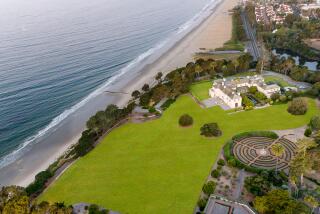French Chateau Reflects Creator’s Flair for the Dramatic
- Share via
In June when Sotheby’s auctions off the Chateau de Groussay and its contents for an anticipated total of $15 million, it won’t be just a mansion on 67 acres outside of Paris that’s being sold.
A legend will be on the block, for this was the home of Charles de Beistegui (1894-1970), an enigmatic interior decorator whose passport was Spanish and whose wealth came from his family’s Mexican silver mines.
The cash reservoir allowed de Beistegui to indulge himself in the homes he decorated, such as his Chateau de Groussay and the 17th century Palace Labia in Venice. The latter was the site in 1951 of a grand costume ball with masked guests Cocteau, Dali, Dior, the Aga Khan, the Rothschilds and other notables; de Beistegui, on stilts, oversaw the proceedings in his costume of long wig and gown.
But it was the chateau that was de Beistegui’s masterpiece and the focus of his life, and it was the chateau that Desmond Guinness, author and president of the Irish Georgian Society, spoke about last month during a lecture sponsored by the Decorative Arts Council of the Los Angeles County Art Museum and Sotheby’s.
“I met Charlie de Beistegui on my honeymoon in 1954,” Guinness says. “My bride and I went to an after-dinner party of his in Venice and were led upstairs by men holding flaming torches. He was really a scene setter. He should have been a set designer.”
It is this theatrical flair that permeates Groussay, from its dramatic library that was created by knocking down four rooms, to the Louis XIII gallery that leads to the Dutch salon featuring 17th century interiors, to the Goya gallery with its modern tapestries based on Goya’s cartoons, that leads to the white-and-gold paneled theater. The jewel-like theater can seat 150 and has walls and curtains of blue and red damask.
“I was always interested in Charlie as a decorator,” Guinness says. “He was fond of [the English style] that uses hunting prints, antlers and even stuffed rabbits in glass cases in the entry. For him, it was nostalgia for England, since he was educated at Eton and Cambridge. He wanted an interior that looked as if it had been improved by several generations living in and loving the house.
“Sometimes he used very cheap items next to expensive ones just to get the look he wanted. One of his legacies is that he knew how to correctly put things together. He was a perfectionist in everything he did. In fact, Orson Welles said that Charlie was even a perfectionist in the women he loved. He preferred duchesses.”
When de Beistegui bought the chateau in 1939, it had no declared historical value, so he was able to make whatever changes he wanted. With the collaboration of architect Emilio Terry, he changed the structure and the decor. He didn’t want a historical reconstruction; instead, he wanted to give the feeling of a mix of different eras. He combined mahogany, bronze, gilt-bronze, heavy fabrics, English chintz and tartans, flowers and checks, and green and blue.
“He used a greeny-blue that was found in Old Master paintings throughout the house,” Guinness says. “In the library with its dark colors, high walls full of paintings and spiral staircase, he covered the furniture with pure white linen. Without doing that, the room would be too dark. He also has all those pictures on the walls, not to be looked at, but just as part of the decoration.”
It’s rumored that Cecil Beaton, who was one of de Beistegui’s friends, was influenced by this library when he designed Henry Higgins’ library in “My Fair Lady.”
“During the war [de Beistegui] had an army of people working there. Guests would come by trains, which would be met by horse-drawn carriages for ladies, with bicycles on top for the men to ride to the chateau,” Guinness explains. During World War II, a Spanish flag flew over the gate at Groussay and the Germans left him alone. De Beistegui, a bachelor, left the estate to a nephew, who is finally putting it up for sale.
“I admire the variety of Charlie’s designs. Just the park alone with its follies is amazing,” Guinness says.
The extensive grounds were created in the spirit of the 18th century, and de Beistegui scattered seven follies--whimsical, conversation-piece structures--on them. The follies included a blue-and-white-striped Turkish tent made of metal lined with 10,000 blue Delft tiles, a Chinese pagoda and an Italian bridge.
Indeed, Guinness says, like the chateau and its follies, “Charlie was one of a kind.”
* The sale of Chateau de Groussay and its contents is June 2-6. For more information, call Sotheby’s at (310) 274-0340.
* The next “Design and Designers” lecture at the Los Angeles Museum of Art is May 25 at 7:30 p.m. Keith Irvine of the New York design firm of Irvine & Flemming will speak on “The Legacy of John Fowler.” For more information, call the council at (323) 857-6528.


